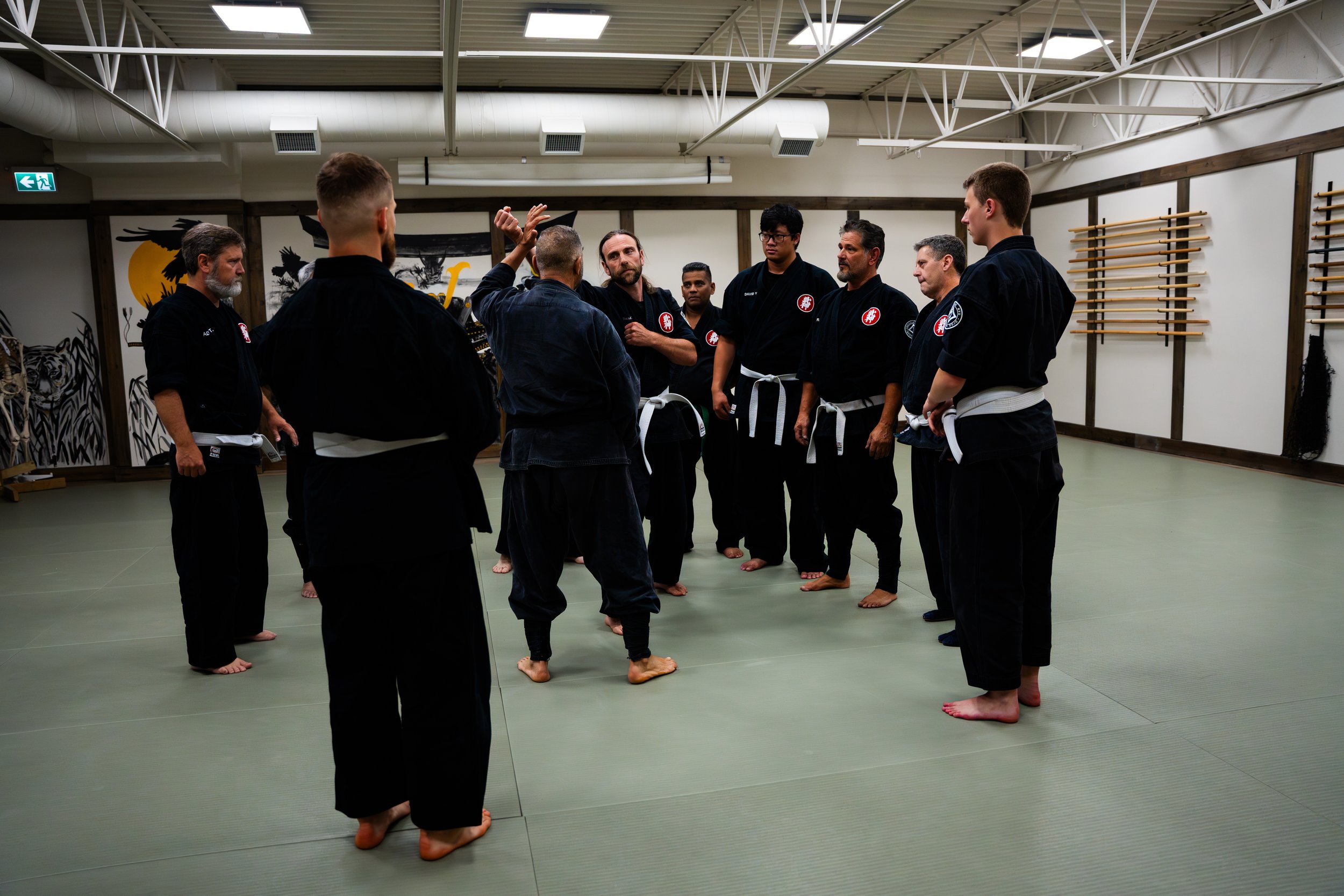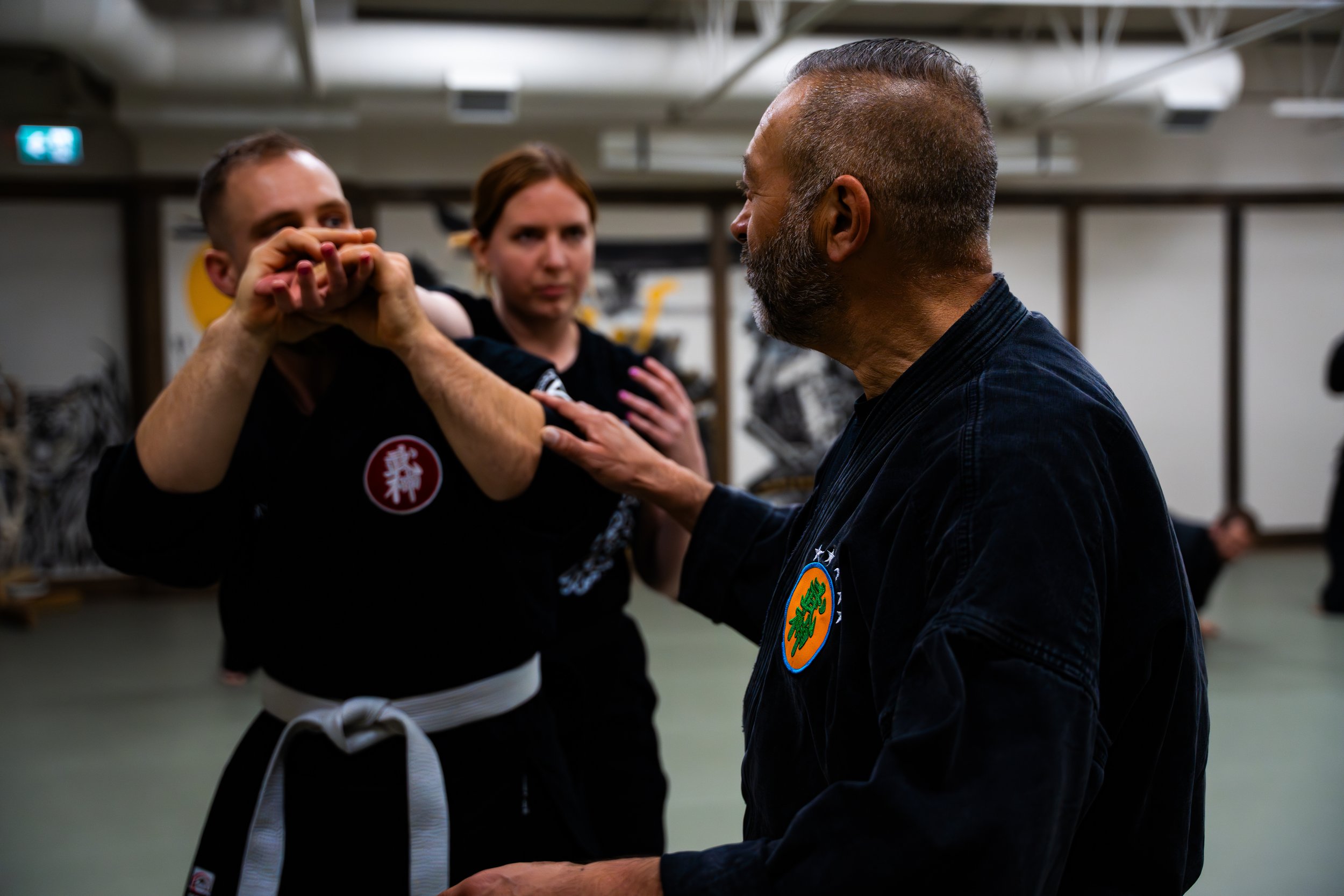CURRICULUM
Due to the highly dynamic nature of combat and conflict in general, no individual fixed form will be sufficient to resolve any form of conflict. Ninjutsu does not segment the art into a structured learning program. Through constant exposure to stress and variation, a student develops the ability to synthesize his or her own technique as needed.
In preliminary stages, this begins with the student learning various skills to develop a set of defensive techniques that can be used in a dynamic nature. Students are also exposed to countless variations of these skills, including the integration of many different traditional and contemporary weapons.
CLASSES
Classes are held twice per week. They run for an hour and a half and include a generous mobility warm-up before splitting the class up into pairs or groups for technique and skills training.
A Student’s Experience
Hey! This is Jon, one of the instructors at the Ninpo Martial Arts Dojo. You’re probably wondering what its like being one of our students, right?
Well, I’ve been training here for over 20 years so let me break it down for you and show you a bunch of cool photos along the way! :)
Class Start - Bowing In
Our students meet in the dojo for solo warm-up 15 minutes before class. A gong signals that it’s time to begin training and students line up along the Kamidana. Sensei performs the starting ritual known as Reishiki. “Shiken haramitsu daikomyo” is said by everyone followed by a series of bows. We celebrate coming together so that we may learn from each other and pay respect to those who came before us. After bowing to Sensei, any announcements are made and then we move into the warm-up.
Warm-Up
Sensei guides us through what’s called “Junan Taiso”. It’s a pre-training exercise designed to increase our flexibility and help prevent injury. We also strengthen ourselves through various body weight movements like push-ups and sit-ups. Many of the techniques involve a series of dynamic movements which lock the joints so it’s important to warm up the entire body. Junan Taiso ends with a short water break.
Taijutsu
Taijutsu is translated as “True Techniques of the Body” and is the foundation which all the physical techniques are applied from.
Taijutsu can be organized into three specific fields:
Dakentaijutsu - Kicking, Punching, and other Striking Skills
Jutaijutsu - Grappling, Wrestling and Ground Fighting, Throwing, Joint-locks, and other Close Contact Skills
Taihenjutsu - Rolling, Jumping, Break-falls, Stepping, Balance, and other Safety Skills
Weapons Training
While Taijutsu forms the foundation of what we study, the other two pillars of our training are Bojutsu and Kenjutsu. Bojutsu teaches us how to use various types of staffs and Kenjutsu teaches us how to use different types of blades. Both of these fields are extremely important as these can be substituted for other objects in modern life.
But the secret and true purpose is in the body positioning and footwork. The staff will expose a student’s imperfections and the sword will teach the student precision. All three fields come together to create a well-rounded practitioner with a good base in self-defense knowledge.
Weapons training is not limited to just staffs and blades, Ninpo also includes historical examples. The fishing net is an underestimated control tool and can be substituted with a jacket or blanket. You’ll have to come visit us to see all our cool toys.
Class End - Bowing Out
After training, Sensei rings the gong once again to signal the end of class. We line up in front of the Kamidana and repeat the ritual of Reishiki and repeat “Shiken Haramitsu Daikomyo”. We have a short period of silent meditation to calm the mind from training. Then Sensei likes to end the class with a short discussion which allows students the time to ask questions and comment on the material covered in class. This concludes one of our training nights.
Questions
-
You can purchase a 3-month trial right here on the website. You’ll need to sign a waiver before your first class but you can do that when you come in to get sized for your uniform. Your trial period purchase includes your uniform.
-
Safety is one of our top priorities in the dojo. Martial arts is a very dynamic activity and accidents can happen but you will learn how to train safely on your first class. We do not have a competitive or sport aspect to our training so training injuries are very rare. But it is a physical activity so some soreness is common.
-
Everyone is capable of doing it unless your personal situation precludes you from certain physical activities. We accept all with the willingness to learn but we do require a certain level of dedication to maintain the high standard of training. We will also turn away people who wont be a good fit for our community.
-
We don’t separate our students into age groups. Teens train with Adults regardless of gender. You will get to meet and train with a lot of different people from all kinds of backgrounds. You don’t get to pick your opponent in real life. Our minimum age is typically 16 but we are willing to accommodate for maturity.
-
Ninpo training is held every Monday and Thursday night. Our doors open at 6pm, class runs from 6:30 to 8, and the doors close at 9pm. Major holidays will be closed. Please check our Calendar for specific days.
If you have any unanswered questions, please reach out to us. We’re happy to answer.



























